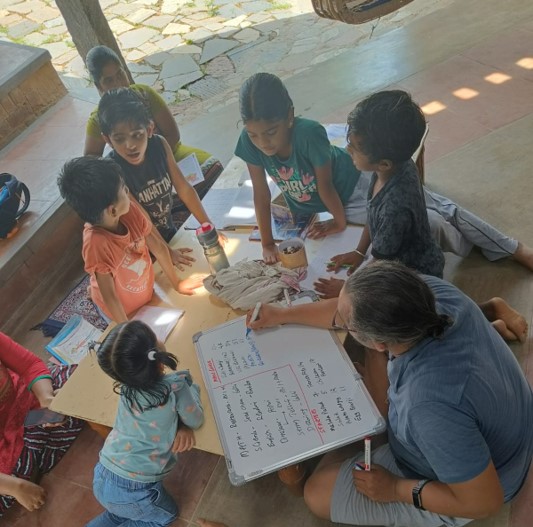Creating a Flexible Learning Environment
Every Monday, Venu gathers with Kishkindha, the cluster of curious young minds that make up Farm Hill’s primary school. His approach to classes is, at first glance, remarkably loose. More than once, I’ve asked what he plans to do with the children, and each time he replies, “I don’t know, let’s see what we end up doing.” For someone used to lesson plans and learning objectives, this can be puzzling. How does one pull off a good class - one where children are learning - by ‘not knowing’ in advance? Isn’t preparation the key?
Over the weeks, I found that preparation looks a little different in classrooms like his.

Flexible Classes - how they look like
If you step into a typical Kishkindha class with Venu, you might see children playing at an imaginary restaurant, wielding colourful slips of paper as currency, poring over menus filled with pizzas, fruits, and other treats. The challenge? Spend your money wisely - how many apples can I buy for 24 rupees? If I buy two bananas, what can I get with the remaining coins? Long division with remainders sneaks into the game, often before the word ‘division’ itself ever appears on a blackboard.
Elsewhere, a child lines up black and white seeds on the floor — tens and ones — sketching out new sums and solutions on the fly. The tools, the context, the stories may shift, but the learning remains palpable.
Come next week, the classroom moves outdoors. Tiny hands gently press seeds into the earth, add a sprinkle of manure, water, and then mulch. Each child watches their spot, waits patiently, and then notices nothing - for days! Unlike the textbook promise that ‘the seed will sprout in a few days,’ nothing emerges. Most would rush ahead, but Venu’s class digs in - they unearth the seed, discover that it’s been nibbled by a resident worm, inspect its remains together. The disappointment becomes discovery, a living lesson richer than any worksheet.
Above all, the children know they have a say. At the start of each session, Venu invites requests. An hour and a half later, all the activities - a game here, a story there, a science experiment - blend seamlessly. Each child finds something to delight in. It looks effortless, but there is much thoughtfulness beneath the surface.
How does one prepare for such classes?
So what does it take for a teacher to facilitate such flexible, student-centred learning?
First, a deep and living grasp of the concepts being explored. The ‘restaurant’ exercise is not just a classroom gimmick - it takes careful thinking to shape it, suggest variations, respond to children’s ideas, and gently nudge the underlying mathematics to the surface. The same goes for garden explorations, or for weaving together a child’s question about worms with a story about cycles in nature.
Second, a willingness to bring more than one plan - a list, perhaps, of possible trails to follow if the morning’s energy is playful or pensive, or if someone comes in with a new curiosity. Here, responsiveness matters more than ticking a set of objectives.
Third, and perhaps most importantly, a continuous habit of observing. What fascinates each child - what games absorb them, what questions keep coming up, what stories do they invent amongst themselves? The spirit of play that fills so much of childhood is not separate from learning - it is, in many ways, the very heart of it.
Somewhere along the way, work and play blur, and learning becomes a natural outgrowth of delight.
What it means for the teacher
What does this mean for those who hold the responsibility of teaching?
Preparing for such learning environments asks us not just for subject knowledge, but for the humility to notice, adapt, and improvise. It means building a kind of cross-domain fluency: seeing how a game about fruits becomes a lesson in division, how a failed sprouting becomes a doorway to ecology, how requests in the classroom open wide doors to new connections.
It also means engaging beyond the classroom - listening to the child’s world, knowing what matters to them outside the lesson, weaving those threads into the fabric of learning.
Perhaps the truest preparation, then, is openness - a willingness to learn alongside children, to trust curiosity as a compass, and to hold learning as an ever-renewing conversation.
At Farm Hill, we believe in nurturing such flexible, playful, and deeply engaging learning spaces - where the teacher is prepared not just with material, but with presence, care, and an open mind. Here, as anywhere, teaching is its own form of lifelong learning.